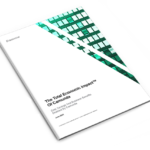Some automation projects can seem like magic. Recently, I got a notice in the mail about the upcoming German elections. By simply scanning a QR code on the mailer, I signed up and registered to get the necessary documents to vote by mail on the election website. From straightforward processes like this, to complex processes like NASA transforming instrument data from the Mars Rover into higher level data products, the journey toward end-to-end process automation rarely happens overnight.
In my recent CamundaCon keynote, I shared that revolutionary automation projects are often evolutionary in nature. In case you missed it, you can view the presentation video on-demand by registering here, or read the recap below.
Across more than 400 customer projects, I’ve noticed four common digital transformation objectives that most organizations share:
- Transforming legacy infrastructure: Most teams need to to work with legacy systems and applications, because ripping and replacing them all at once would be far too costly and disruptive.
- Aligning a complex stakeholder set: Large enterprises have a wide variety of stakeholders to address with automation, including devs, architects, automation leads, business users, CFOs, legal departments and more.
- Increasing developer productivity: Today, all companies are software companies. Yet, developer resources are scarce. The goal is to make people more productive with process automation, without having to be highly specialized software developers.
- Ensuring scalability and resilience: Mission-critical core business processes must run reliably regardless of transaction loads or anomalous circumstances.
It takes major perseverance to overcome the challenges associated with these objectives to push a successful automation project forward. We’ve learned from our customers’ experiences, which have formed the basis of our product vision.
Inside Camunda’s Product Vision
We launched Camunda eight years ago as an automation workflow engine that was embeddable into Java applications. In 2015, we made the most important breakthrough for our product by making it independent of Java. The most significant part of this transition was enabling “pull” work instead of “push” work, allowing us to incorporate vast sets of participants into an end-to-end process. This includes people, business rules, microservices, IoT applications, RPA bots and more.
Rather than a workflow engine buried within one Java application, the Camunda Platform became an orchestration layer that distributes work across any of these endpoints for true end-to-end process automation. We call this the Universal Process Orchestrator, because it empowers our customers to orchestrate anything, and therefore automate everything. How does this product vision help our customers achieve the objectives listed above? Let’s run through some specific examples of their deployments to learn more.
How Customers Are Reaching Digital Transformation Objectives
First, let’s look at Deutsche Telekom, who used Camunda to achieve the key objective of transforming legacy infrastructure. Deutsche Telekom originally introduced RPA for local task automation. Over time they found that the thousands of bots they deployed were difficult to manage and maintain operationally, leading them to lose control of the end-to-end process flow. In the beginning, they used Camunda as a bot orchestration layer. Now, they’re in the process of moving from RPA-based automation to API-based automation. Their goal is to replace bots with APIs, without changing the process within Camunda. This enables them to gradually modernize the legacy infrastructure that justifies RPA in the first place, without disrupting their business.
Most of our customers are standardizing on the business process model and notation (BPMN) and/or decision model notation (DMN) standards to help with the second objective of aligning a diverse group of stakeholders. Just as English is the lingua franca of the business world, BPMN is the standard language for process automation, allowing any stakeholder to communicate regardless of their level of technical expertise. All of our products within the Camunda Platform empower organizations to use these standards, from process design via Camunda Modeler all the way to Camunda Optimize to ensure continuous improvement throughout the project’s lifecycle.
For our next objective, let’s look at how companies are most often using Camunda. According to a recent survey, 53% of our customers are using Camunda to move to the cloud and modernize their applications, while 23% are building a centralized process automation platform.
These are massive efforts that involve a lot of development resources. We’ve listened to this customer feedback and found that many developers are not hardcore Java experts, yet still are heavily involved in automation projects As a result, we’re experimenting with ways to guide these less specialized developers in their automation efforts, helping to make them more productive. New shortcuts for developers will make onboarding easier for Camunda newbies, without falling into the low-code trap of creating more walled gardens that lack openness and flexibility.
For the final objective of ensuring scalability and resilience, we’ve been able to help leading financial services institutions like Goldman Sachs scale their core banking operations with Camunda Cloud. Providing high availability is often overlooked and rarely addressed by RPA and low-code vendors, yet has been a big part of our R&D efforts. Our platform enables massive scalability and redundancy, helping to ensure that any critical, core business processes remain up and running.
Thanks for following along with how our product vision aligns to our customers’ efforts toward evolutionary and revolutionary transformations. Want to learn more about how our customers are achieving their business objectives with automation and orchestration?
Read the Forrester Consulting Total Economic Impact Report.

The Total Economic Impact™ Of Camunda
View the TEI study to learn more about how Camunda customers have achieved a 389% ROI in part due to:
- Achieving a 3X faster development time
- Improved collaboration between business and IT
- Reducing the time to complete standard processes by over 98%

